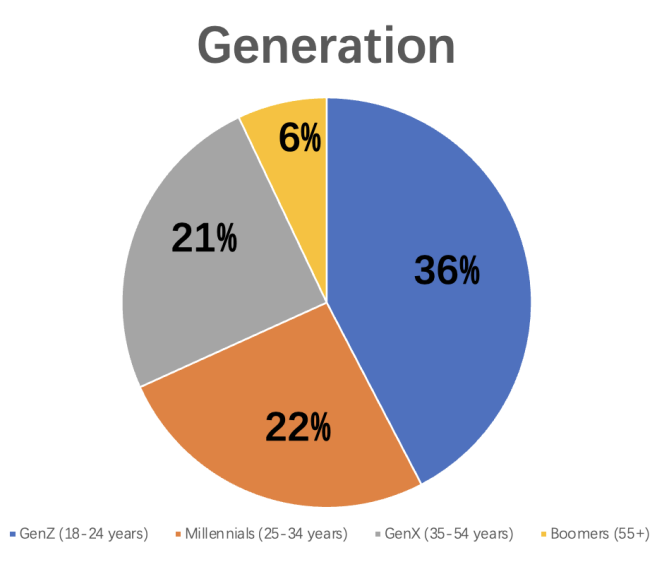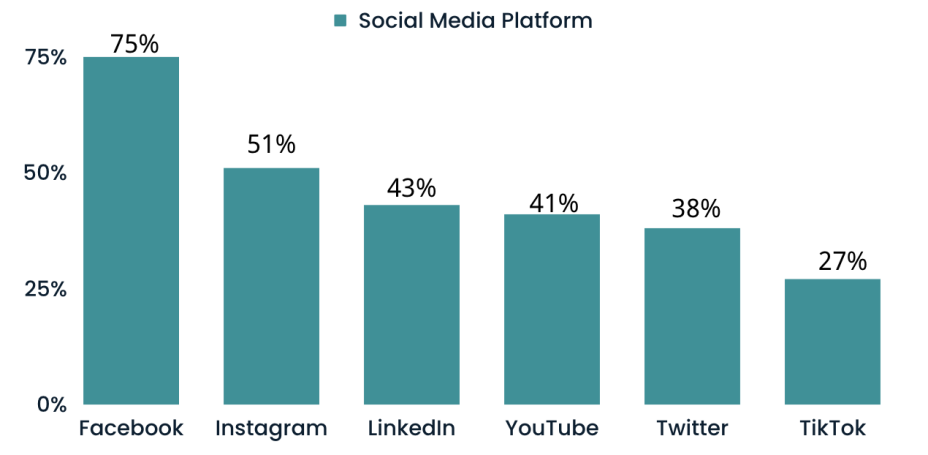1. Introduction
In recent years, the development of the Internet has changed people's way of life, online sales have become more and more popular, far more than the traditional sales model. Some merchants have opened online stores and can provide consumers with a good consumer experience. The online selling model is not limited to online stores, but many merchants are actively generating revenue through various social media platforms that rely on a combination of advertising, e-commerce, and other monetization strategies. Particularly during the COVID-19 period, many businesses were forced to close their stores, and the long period of closure led to inventory buildup and closure. Therefore, many merchants opened online stores to clear their inventory, also promoted their brands through social media, such as Jitterbug, Instagram, and Facebook [1].
For consumers, choosing to shop online is not only about shopping satisfaction but also about entertainment and relaxation through evening shopping [2]. This is known as hedonic motivation, where people are free to browse products online and add their favorite items to their shopping carts. It provides consumers with the means to escape boredom, gain entertainment, and experience enjoyment [3]. This hedonic initiative took place mainly during the COVID-19 period, when consumers were unable to socialize outside due to the closure of regular retail stores, so they had to resort to the Internet to use online shopping as a form of entertainment, making it the only means of satisfying consumers' consumer needs [4]. In addition, some would regard the act of adding favorite items to the shopping cart as a stress-relieving behavior. This trend of activity satisfaction and social development has contributed to the development of online sales [5].
The article demonstrates current trends in online shopping by analyzing social media in terms of marketing channels, customer engagement strategies, social media platform selection, and maximizing return on investment. It also uses Amazon as an example to understand the importance of companies utilizing social media platforms for strategic decision making.
2. Social media platforms and marketing
2.1. Social media - one of the efficient marketing channels
People have been using the Internet for many years, with 93% of respondents visiting online stores at least once a month, while 55% visit at least once a week. They browse online for items they need, and the main categories they browse are clothing and accessories, electronics, music, travel, and concert or sports event tickets. Sales professionals who use social media to close 40%-50% more sales than those who do not use social media [6]. This phenomenon occurs because social media sells help salespeople find more potential customers. Sales professionals with a strong social selling index on LinkedIn close 45% more sales than those without a social selling index. Social media will have a simpler and wider audience base and leads, and it is a great way to generate sales and increase revenue. Experienced online salespeople will choose the platform according to its characteristics to promote their products. Alternatively, buyer personas can reveal targeted information such as age, interests, geographic location, industry, and browsing behavior to select the right social media promotion method and platform.
2.2. Customer Engagement
Online shopping can be used to connect customers with brands through deepening engagement, which is defined as behavioral performance and includes a number of related behaviors such as word of mouth, blogging, providing customer ratings [7]. As of April 2023, there are 4.8 billion social media users worldwide who share their purchases on social media and label the items with their brands [6]. Dominate the e-market in Chinese is Taobao [8]. Numerous merchants register merchant accounts on the Taobao platform for direct sales and gain high customer loyalty through online communication and good after-sales service. In terms of customer engagement, LEGO has an excellent marketing approach. The LEGO Digital Designer application allows customers to participate in designing their own player models, and allows customers to vote for the most creative design for mass production. The customer engagement and experience is dramatically enhanced [9].
Meanwhile, social media has evolved into a search engine, with some customers searching and finding sellers on social media based on their needs [10]. In the US and Canada, 42% of buyers are contacted by sellers who view their LinkedIn profiles [6]. Different generations of consumers with different consumption attitudes search for brands on social media with different frequencies, where there is still a large proportion of young to middle-aged people who are the primary consumption force, suggesting that there has been a shift in selling patterns (Figure 1).

Figure 1: Percentage of generation using social media to search for products [6]
2.3. Selection of Social Platforms
Currently, there are many social media platforms on the Internet that have shopping sections, so the percentage of social media usage was ranked based on the popularity of the social media platforms themselves and the habits of people who use social media on a daily basis, as shown in Figure 2. Among them, Facebook and Instagram continue to be the more frequently used social platforms today.

Figure 2: Ranking of Social Media Usage Percentage [6]
The choice of social media platforms is an important choice for merchants' marketing strategies and sales channel decisions, so it is important to be clear about the platforms' areas of specialization and platform characteristics. Social media platforms can be categorized into image category platforms (Pinterest, Instagram and Tumblr), video networks (Jitterbug, YouTube), business platforms (LinkedIn), and SEO and author platform (Google+). Merchants need to make different marketing content and approach to platform characteristics.
2.4. Maximize Return on Investment (ROI) with social media platforms
Advertising is the most revenue for social media platforms [11], so social media also provides a high-quality promotional platform for merchants' advertising and marketing. Merchants can use social media platforms' traffic, users, publicity, and other resources for brand promotion to maximize marketing ROI, and commonly used promotional methods include display ads, SEO rankings, artificial intelligence, and hot traffic time slots. First of all, display ads on social media allow merchants to place display ads on platforms where potential customers are browsing. For example, push information about air tickets and hotels on travel platforms. Secondly, since the competition for online sales is very high, social media ensures more exposure to merchants by improving SEO rankings and allowing merchants to appear in the first few search results ranking. It can also make keywords more relevant to potential customers of the business by setting up search keywords. Further, Artificial Intelligence (AI) in social media can drastically reduce the difficulty of selling for businesses by helping them understand customer needs and discover customer segments faster [12]. By recognizing the patterns, trends, and relevance of customer search, browsing, and purchasing, valuable information can be derived from them, providing salespeople with a better basis for decision-making and action [11]. AI can also help companies be more efficient in digital marketing by helping sales write marketing emails and social media scripts, track back-office data and summarize data.
In addition, hot traffic times period on social platforms are one of the easiest ways to market hotspots. Businesses need to go to the peak of the major platforms hotspots to post posts that can get more exposure and views. The major platforms peak traffic time period is shown in Table 1.
Table 1: The major platforms peak traffic time period
Platform | Hot traffic time period |
9 a.m. to 12 p.m. | |
TikTok | 3 p.m. to 9 p.m. |
12 p.m. to 6 p.m. | |
9 a.m. to 3 p.m. | |
YouTube | 3 p.m. to 6 p.m. |
9 a.m. to 3 p.m |
3. Case - Amazon
Amazon is currently one of the world's largest Internet-based online retailers, and this online business has changed the way people around the world conduct business. Amazon's digital marketing strategy is comprehensive and they reach their customers through digital marketing.
3.1. Amazon and social media platforms
Amazon's official account has 10 million followers on Facebook, and it mainly uses Facebook to share company news and advertisements. In Facebook promotion, it mainly uses strong advertisements to publicize its promotional days, and also stays up to date on a daily basis by posting different topics [13]. Amazon on Instagram and Facebook have very similar marketing strategies, both social media platforms post similar content. Amazon has 2.8 million followers on the Instagram social platform, where it mainly posts updates about company news. And by interacting with customers on Instagram, customers can attract more potential customers by sharing Amazon's products on Instagram. Moreover, YouTube is a social media platform in the form of video, and the biggest feature of YouTube is to attract people's attention through advertisements. Amazon places interesting and valuable ads on the YouTube platform. Most of the time, it does this by making its customers feel special [13].
3.2. Social media and sales
Amazon started as an offline brick-and-mortar store, and online marketing was the first step in Amazon's business transformation. Amazon sells books on the New York Times bestseller list, and the longer a book is on the bestseller list, the higher the Amazon sales. Data shows that "a logarithmic increase of 1 in the sales rank increases the number of reviews by 282" [14]. This means that media has a positive impact on sales. People liking, commenting and retweeting on social media increases consumer engagement with the topic and also increases the buzz around the product. Attention was drawn to the product and these results suggest that social media has a positive impact on sales [14]. Amazon's long-term performance since 1999 demonstrates the managerial implications of this strategy, where companies can use free media by promoting their reach to consumers rather than direct opt-in messaging. For example, Amazon makes the bestseller list accessible to non-New York Times readers by displaying it on Amazon.com. While we analyze only one combination of earned media (social media and traditional media), other combinations are possible. Using multiple winning media can provide traditional advantages such as individual media effects and synergies [14].
4. Conclusion
Social media is one of the efficient marketing channels where merchants can get more exposure and conversion rate through the traffic and novel sales models on the platform, thus improving the number of potential customers. Meanwhile, the increased customer engagement on social media will also help businesses gain more profits. Companies should not only use social media platforms for marketing, but also learn the marketing strategy of social media platforms, and show the special aspects of online marketing through network traffic hotspots. Therefore, according to the current trend analysis, social media platform sales have a very advantageous development prospect. However, this paper is mainly based on the application of social media in the analysis process, without researching the actual sales data of merchants, so as to come up with strong data to justify the relationship between social media and company marketing.
References
[1]. Fernie, J. Online Shopping. Bradford, England: Emerald Group, 2005. International Journal of Retail & Distribution Management Incorporating Retail Insights.
[2]. Close, A. G., & Kukar-Kinney, M. (2010). Beyond buying: Motivations behind consumers' online shopping cart use. Journal of Business Research, 63(9-10), 986-992.
[3]. Wolfinbarger, M., & Gilly, M. C. (2001). Shopping online for freedom, control, and fun. California management review, 43(2), 34-55.
[4]. Koch, J., Frommeyer, B., & Schewe, G. (2020). Online shopping motives during the COVID-19 pandemic—lessons from the crisis. Sustainability, 12(24), 10247.
[5]. Childers, T. L., Carr, C. L., Peck, J., & Carson, S. (2001). Hedonic and utilitarian motivations for online retail shopping behavior. Journal of retailing, 77(4), 511-535..
[6]. Alfred, L. (2023, August 16). 50 social selling statistics you need to know in 2023. HubSpot Blog. https://blog.hubspot.com/sales/social-selling-stats
[7]. Bijmolt, T. H., Leeflang, P. S., Block, F., Eisenbeiss, M., Hardie, B. G., Lemmens, A., & Saffert, P. (2010). "Analytics for Customer Engagement,", Journal of Service Research, 13(3), pp. 341-356.
[8]. Cheung, C. M., Zheng, X., & Lee, M. K. (2014, January). Customer loyalty to C2C online shopping platforms: An exploration of the role of customer engagement. In 2014 47th Hawaii International Conference on System Sciences (pp. 3065-3072). IEEE.
[9]. Al-Khateeb, B., Jaoua, F., & Mohamed, E. (2023). The Impact of Attitude Towards Online Shopping in Strengthening the Relationship Between Online Shopping Experience and E-Customer Engagement. International Journal of Customer Relationship Marketing and Management, 14(1), 1-25.
[10]. Kamis, A. A., & Stohr, E. A. (2006). Parametric search engines: What makes them effective when shopping online for differentiated products?. Information & Management, 43(7), 904-918.
[11]. Martínez-López, F. J., Li, Y., & Young, S. M. (2022). Social Media Monetization (Future of business and finance). Cham: Springer International Publishing AG.
[12]. Rainsberger, L. (2022). AI - the New Intelligence in Sales. 1st ed. Wiesbaden: Springer Vieweg. in Springer Fachmedien Wiesbaden GmbH.
[13]. Panagiotelis, A., Smith, M., & Danaher, P. (2014). From Amazon to Apple: Modeling Online Retail Sales, Purchase Incidence, and Visit Behavior. Journal of Business & Economic Statistics, 32(1), 14-29.
[14]. Bao, T., & Chang, T. (2014). Why Amazon uses both the New York Times Best Seller List and customer reviews: An empirical study of multiplier effects on product sales from multiple earned media. Decision Support Systems, 67, 1-8.
Cite this article
Fan,Z. (2024). Research on the Social Media and Online Sales. Advances in Economics, Management and Political Sciences,79,76-81.
Data availability
The datasets used and/or analyzed during the current study will be available from the authors upon reasonable request.
Disclaimer/Publisher's Note
The statements, opinions and data contained in all publications are solely those of the individual author(s) and contributor(s) and not of EWA Publishing and/or the editor(s). EWA Publishing and/or the editor(s) disclaim responsibility for any injury to people or property resulting from any ideas, methods, instructions or products referred to in the content.
About volume
Volume title: Proceedings of the 3rd International Conference on Business and Policy Studies
© 2024 by the author(s). Licensee EWA Publishing, Oxford, UK. This article is an open access article distributed under the terms and
conditions of the Creative Commons Attribution (CC BY) license. Authors who
publish this series agree to the following terms:
1. Authors retain copyright and grant the series right of first publication with the work simultaneously licensed under a Creative Commons
Attribution License that allows others to share the work with an acknowledgment of the work's authorship and initial publication in this
series.
2. Authors are able to enter into separate, additional contractual arrangements for the non-exclusive distribution of the series's published
version of the work (e.g., post it to an institutional repository or publish it in a book), with an acknowledgment of its initial
publication in this series.
3. Authors are permitted and encouraged to post their work online (e.g., in institutional repositories or on their website) prior to and
during the submission process, as it can lead to productive exchanges, as well as earlier and greater citation of published work (See
Open access policy for details).
References
[1]. Fernie, J. Online Shopping. Bradford, England: Emerald Group, 2005. International Journal of Retail & Distribution Management Incorporating Retail Insights.
[2]. Close, A. G., & Kukar-Kinney, M. (2010). Beyond buying: Motivations behind consumers' online shopping cart use. Journal of Business Research, 63(9-10), 986-992.
[3]. Wolfinbarger, M., & Gilly, M. C. (2001). Shopping online for freedom, control, and fun. California management review, 43(2), 34-55.
[4]. Koch, J., Frommeyer, B., & Schewe, G. (2020). Online shopping motives during the COVID-19 pandemic—lessons from the crisis. Sustainability, 12(24), 10247.
[5]. Childers, T. L., Carr, C. L., Peck, J., & Carson, S. (2001). Hedonic and utilitarian motivations for online retail shopping behavior. Journal of retailing, 77(4), 511-535..
[6]. Alfred, L. (2023, August 16). 50 social selling statistics you need to know in 2023. HubSpot Blog. https://blog.hubspot.com/sales/social-selling-stats
[7]. Bijmolt, T. H., Leeflang, P. S., Block, F., Eisenbeiss, M., Hardie, B. G., Lemmens, A., & Saffert, P. (2010). "Analytics for Customer Engagement,", Journal of Service Research, 13(3), pp. 341-356.
[8]. Cheung, C. M., Zheng, X., & Lee, M. K. (2014, January). Customer loyalty to C2C online shopping platforms: An exploration of the role of customer engagement. In 2014 47th Hawaii International Conference on System Sciences (pp. 3065-3072). IEEE.
[9]. Al-Khateeb, B., Jaoua, F., & Mohamed, E. (2023). The Impact of Attitude Towards Online Shopping in Strengthening the Relationship Between Online Shopping Experience and E-Customer Engagement. International Journal of Customer Relationship Marketing and Management, 14(1), 1-25.
[10]. Kamis, A. A., & Stohr, E. A. (2006). Parametric search engines: What makes them effective when shopping online for differentiated products?. Information & Management, 43(7), 904-918.
[11]. Martínez-López, F. J., Li, Y., & Young, S. M. (2022). Social Media Monetization (Future of business and finance). Cham: Springer International Publishing AG.
[12]. Rainsberger, L. (2022). AI - the New Intelligence in Sales. 1st ed. Wiesbaden: Springer Vieweg. in Springer Fachmedien Wiesbaden GmbH.
[13]. Panagiotelis, A., Smith, M., & Danaher, P. (2014). From Amazon to Apple: Modeling Online Retail Sales, Purchase Incidence, and Visit Behavior. Journal of Business & Economic Statistics, 32(1), 14-29.
[14]. Bao, T., & Chang, T. (2014). Why Amazon uses both the New York Times Best Seller List and customer reviews: An empirical study of multiplier effects on product sales from multiple earned media. Decision Support Systems, 67, 1-8.









